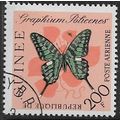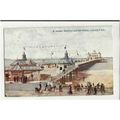Lake Titicaca, Peru - Uros floating island people & houses - postcard c.1980s
- Condition : Used
- Dispatch : 2 Days
- Brand : None
- ID# : 179909617
- Quantity : 1 item
- Views : 162
- Location : United Kingdom

- Seller : justthebook (+1704)
- Barcode : None
- Start : Sat 20 Apr 2019 20:24:56 (BST)
- Close : Run Until Sold
- Remain : Run Until Sold
More Listings from This Seller view all
Seller's Description
- Postcard
- Picture / Image: Houses and natives in Uros floating island in Lake Titicaca [Peru]
- Publisher: Corimuter, Lima, Peru
- Postally used: no
- Stamp: n/a
- Postmark(s): n/a
- Sent to: n/a
- Notes / condition:
Please ask if you need any other information and I will do the best I can to answer.
Image may be low res for illustrative purposes - if you need a higher definition image then please contact me and I may be able to send one. No cards have been trimmed (unless stated).
------------------------------------------------
Postage & Packing:
Postage and packing charge should be showing for your location (contact if not sure).
No additional charges for more than one postcard. You can buy as many postcards from me as you like and you will just pay the fee above once. Please wait for combined invoice. (If buying postcards with other things such as books, please contact or wait for invoice before paying).
Payment Methods:
UK - PayPal, Cheque (from UK bank) or postal order
Outside UK: PayPal ONLY (unless otherwise stated) please. NO non-UK currency checks or money orders (sorry).
NOTE: All postcards are sent in brand new stiffened envelopes which I have bought for the task. These are specially made to protect postcards and you may be able to re-use them. In addition there are other costs to sending so the above charge is not just for the stamp!
I will give a full refund if you are not fully satisfied with the postcard.
----------------------------------------------
Text from the free encyclopedia WIKIPEDIA may appear below to give a little background information (internal links may not work) :
*************
Titicaca (in the hispanicized spelling) or Titiqaqa (Quechua) is a large, deep lake in the Andes on the border of Peru and Bolivia. By volume of water, it is the largest lake in South America.[2][3] Lake Maracaibo has a larger surface area, though some consider it to be a large brackish bay due to its direct connection with the sea.
It is often called the highest navigable lake in the world, with a surface elevation of 3,812 metres (12,507 ft).[4][5] Although this refers to navigation by large boats, it is generally considered to mean commercial craft. For many years the largest vessel afloat on the lake was the 2,200-ton, 79-metre (259 ft) SS Ollanta. Today the largest vessel is probably the similarly sized, but broader, train barge/float Manco Capac, operated by PeruRail (berthed, as of 17 June 2013,
The lake is located at the northern end of the endorheic Altiplano basin high in the Andes on the border of Peru and Bolivia. The western part of the lake lies within the Puno Region of Peru, and the eastern side is located in the Bolivian La Paz Department.
The lake is composed of two nearly separate sub-basins connected by the Strait of Tiquina, which is 800 m (2,620 ft) across at the narrowest point. The larger sub-basin, Lago Grande (also called Lago Chucuito), has a mean depth of 135 m (443 ft) and a maximum depth of 284 m (932 ft). The smaller sub-basin, Wiñaymarka (also called Lago Pequeño, "little lake"), has a mean depth of 9 m (30 ft) and a maximum depth of 40 m (131 ft).[7] The overall average depth of the lake is 107 m (351 ft).[1]
Five major river systems feed into Lake Titicaca.[8] In order of their relative flow volumes these are Ramis, Coata, Ilave, Huancané, and Suchez.[2] More than twenty other smaller streams empty into Titicaca, and the lake has 41 islands, some of which are densely populated.
Having only a single season of free circulation, the lake is monomictic,[9][10] and water passes through Lago Huiñaimarca and flows out the single outlet at the Río Desaguadero,[11] which then flows south through Bolivia to Lake Poopó. This only accounts for about 10% of the lake's water balance. Evapotranspiration, caused by strong winds and intense sunlight at high altitude, balances the remaining 90% of the water loss. It is nearly a closed lake.[2][7][12]
Since 2000 Lake Titicaca has experienced constantly receding water levels. Between April and November 2009 alone the water level dropped by 81 cm (32 in), reaching the lowest level since 1949. This drop is caused by shortened rainy seasons and the melting of glaciers feeding the tributaries of the lake.[13][14] Water pollution is also an increasing concern because cities in the Titicaca watershed grow, sometimes outpacing solid waste and sewage treatment infrastructure.[15] According to the Global Nature Fund (GNF), Titicaca's biodiversity is threatened by water pollution and the introduction of new species by humans.[16] Already in 2012, the GNF nominated the lake "Threatened Lake of the Year".
The Uros (Uru: Qhas Qut suñi) are a people who live on forty-two self-fashioned floating islands in Lake Titicaca Puno, Peru and Bolivia. They form three main groups: Uru-Chipayas, Uru-Muratos and the Uru-Iruitos. The latter are still located on the Bolivian side of Lake Titicaca and Desaguadero River.
The Uros descend from a millennial town that, according to legends, are "pukinas" who speak Uro or Pukina and that believe they are the owners of the lake and water. Uros used to say that they have black blood because they did not feel the cold. Also they call themselves "Lupihaques" (Sons of The Sun). Nowadays, Uros do not speak the Uro language, nor practice their old beliefs but keep some old customs.[2]
The purpose of the island settlements was originally defensive, and if a threat arose they could be moved. The largest island retains a watchtower almost entirely constructed of reeds.[citation needed]
The Uros traded with the Aymara tribe on the mainland, intermarrying with them and eventually abandoning the Uro language for that of the Aymara. About 500 years ago they lost their original language. When conquered by the Inca empire, they had to pay taxes to them, and often were made slaves.[citation needed]
The Uros use bundles of dried totora reeds to make reed boats (balsas mats), and to make the islands themselves.[3]
The larger islands house about ten families, while smaller ones, only about thirty meters wide, house only two or three.[4]
The islets are made of totora reeds, which grow in the lake. The dense roots that the plants develop and interweave form a natural layer called Khili (about one to two meters thick) that support the islands. They are anchored with ropes attached to sticks driven into the bottom of the lake. The reeds at the bottoms of the islands rot away fairly quickly, so new reeds are added to the top constantly, about every three months; this is what makes it exciting for tourists when walking on the island.[2] This is especially important in the rainy season when the reeds rot much faster. The islands last about thirty years.[citation needed]
Each step on an island sinks about 2-4" depending on the density of the ground underfoot. As the reeds dry, they break up more and more as they are walked upon. As the reed breaks up and moisture gets to it, it rots, and a new layer has to be added to it. It is a lot of work to maintain the islands. Because the people living there are so infiltrated with tourists now, they have less time to maintain everything, so they have to work even harder in order to keep up with the tourists and with the maintenance of their island.[citation needed] Tourism provides financial opportunities for the natives, while simultaneously challenging their traditional lifestyle.
The Uros islands at 3810 meters above sea level are just five kilometers west from Puno port.[4] Around 2,000 descendants of the Uros were counted in the 1997 census,[2] although only a few hundred still live on and maintain the islands; most have moved to the mainland. The Uros also bury their dead on the mainland in special cemeteries.
Food is cooked with fires placed on piles of stones. To relieve themselves, tiny 'outhouse' islands are near the main islands. The ground root absorbs the waste.
Much of the Uros' diet and medicine also revolve around the same totora reeds used to construct the islands. When a reed is pulled, the white bottom is often eaten for iodine. This prevents goitres. This white part of the reed is called the chullo (Aymara [tʃʼuʎo]). Like the Andean people of Peru rely on the Coca Leaf for relief from a harsh climate and hunger, the Uros rely on the Totora reeds in the same way. When in pain, the reed is wrapped around the place in pain to absorb it. Also if it is hot outside, they roll the white part of the reed in their hands and split it open, placing the reed on their forehead. In this stage, it is very cool to the touch. The white part of the reed is also used to help ease alcohol-related hangovers. It is a primary source of food. They also make a reed flower tea.
Local residents fish ispi, carachi and catfish. Trout was introduced to the lake from Canada in 1940, and kingfish was introduced from Argentina. Uros also hunt birds such as seagulls, ducksand flamingos, and graze their cattle on the islets. They also run crafts stalls aimed at the numerous tourists who land on ten of the islands each year. They barter totora reeds on the mainland in Puno to get products they need, such as quinoa and other foods.
- Postcard
Listing Information
| Listing Type | Gallery Listing |
| Listing ID# | 179909617 |
| Start Time | Sat 20 Apr 2019 20:24:56 (BST) |
| Close Time | Run Until Sold |
| Starting Bid | Fixed Price (no bidding) |
| Item Condition | Used |
| Bids | 0 |
| Views | 162 |
| Dispatch Time | 2 Days |
| Quantity | 1 |
| Location | United Kingdom |
| Auto Extend | No |




 for 1 item(s)
for 1 item(s)

















